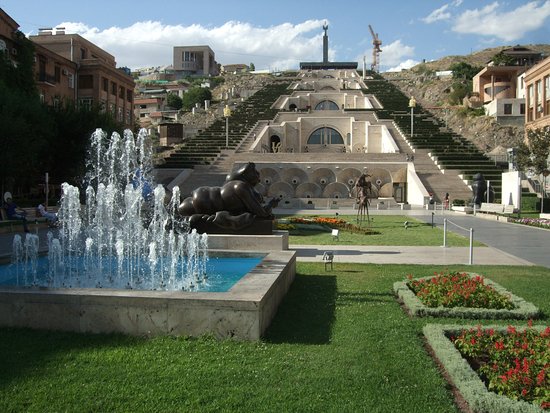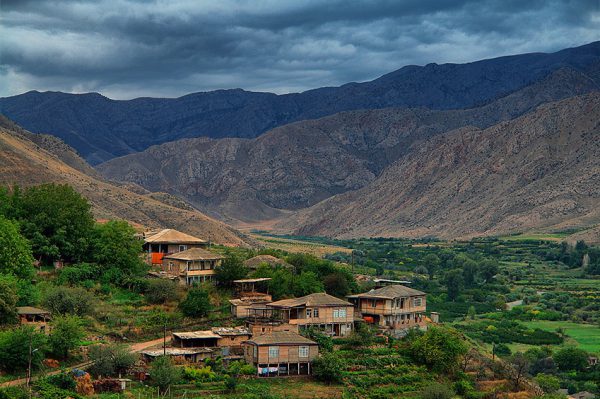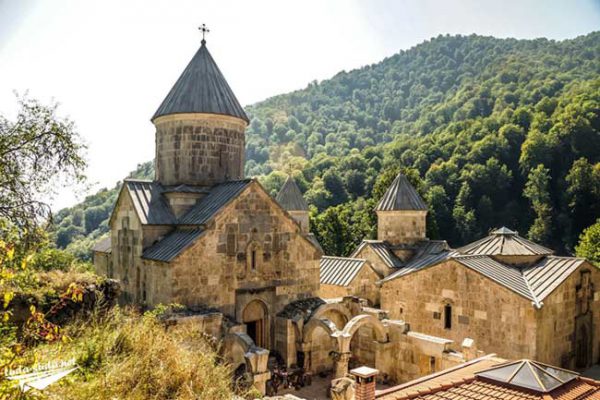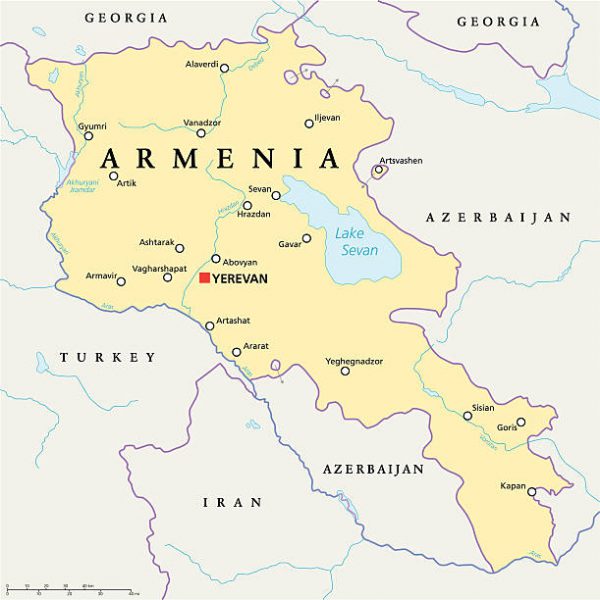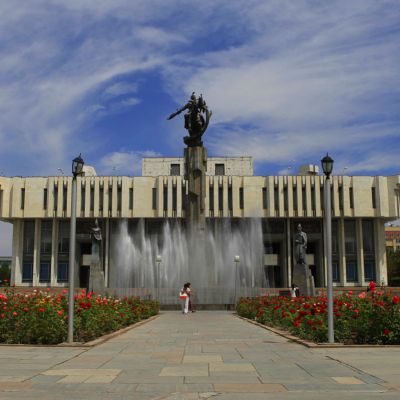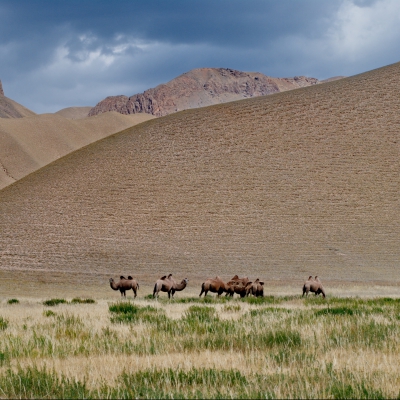Armenia
Armenia is a mountainous country in the South Caucasus region of Eurasia. Located at the crossroads of Western Asia and Eastern Europe, has borders with Turkey to the west, with Georgia to the north, with independent Republic of Nagorno-Karabakh and Azerbaijan to the east, and Iran and Nakhchivan autonomous region to the south. Armenia is a unitary, multi-party, democratic nation-state with an ancient cultural heritage. The Satrapy of Armenia was established in the 6th century BC, after the fall of Urartu. In the first century BC the Kingdom of Armenia reached its height under Tigran the Great. Armenia became the first state in the world to adopt Christianity as a state religion, in the early years of the 4th century (in 301 AD). For this reason, Armenia is considered to be the first Christian nation.
Armenia is situated along the route of the Great Silk Road, it has fallen within the orbit of a number of cultural influences and empires. It is one of the earliest Christian civilizations; its first churches were founded in the fourth century. Its rich cultural and architectural heritage combines elements from different traditions.
Geography of Armenia
Armenia is a landlocked country in Transcausasia region, between the Black and Caspian Seas, bordered on the north and east by Georgia and Azerbaijan and on the south and west by Iran and Turkey.
The terrain is mostly mountainous and flat, with fast flowing rivers and few forests but with many trees. The climate is highland continental: hot summers and cold winters. The land rises to 4,095 m above sea-level at Mount Aragats.
The flora of Armenia is very diverse, since it is situated on the joint of two geobotanical provinces – Caucasian and Iranian.
The prevailing is the semi-desert, mountain-steppe, mountain-meadow and Alpine vegetation.
Grassland – cereal and stipa steppes are replaced by meadow steppes and the Alpine meadows in high-mountains.
The woods occupy about 12% of the area of the country and are, basically, in the northeast and southeast. Widespread in the northeast are broad-leaved woods with the prevalence of oaks, beeches and hornbeams with some lindens, maples, and ash-trees.
Poplars and walnuts, wild fruit-trees and bushes (apple-trees, pear, cherry, plum, cornelian cherry, and dog rose) are often found therе.
The rocky and stony soils are grown with bushes – almond and pistachios, Jerusalem thorn, and beans. The flora of Armenia includes about 3,200 species including 106 endemics.
The fauna of Armenia consists of 76 species of mammals, 304 kinds of birds, 44 kinds of reptiles, 6 kinds of amphibious, 24 kinds of fishes and about10 thousand invertebrates.
Each natural zone is characterized by its unique fauna. In semi-deserts there are rodents (gophers, jerboas, mole rats, hedgehogs, gerbils, voles) and reptiles (agamas, turtles, blunt-nosed vipers, vipers). In steppes live hares and foxes, wolves and badgers, bezoar goats and moufflons.
The fauna of woods is rather rich. There are roebucks, wild boars, bears, Persian squirrels, deer, lynxes, wood cats, and forest dormice. The birds – nightingales, titmice, jays, hawks.
In the Alpine meadows – lynxes, wood cats, martens, bezoar goats, moufflons, wild boars, bears, roebucks, leopards, squirrels, wood cats, and royal deer.
The lynx, jungle cat, wild boar, jackal and numerous birds are found in the Araks river bank thickets and Lake Sevan: the crane (the national symbol of the country), stork, partridge, quail, black grouse, eagle, vulture, snowcock, ducks and seagulls.
History of Armenia
Armenia lies in the highlands surrounding the mountains of Ararat. There is evidence of an early civilization in Armenia in the Bronze Age and earlier, dating to about 4000 BC. Archaeological surveys in 2010 and 2011 at the Areni-1 cave complex have resulted in the discovery of the world’s earliest known leather shoe, skirt, and wine-producing facility.
Several Bronze Age states flourished in the area of Greater Armenia, including the Hittites (at the height of their power), Mitanni (southwestern historical Armenia), and Hayasa-Azzi (1500–1200 BC). The Nairi people (12th to 9th centuries BC) and Urartu (1000–600 BC) successively established their sovereignty over the Armenian Highlands. Each of the aforementioned nations and tribes participated in the ethno genesis of the Armenians. A large cuneiform lapidary inscription found in Yerevan established that the modern capital of Armenia was founded in the summer of 782 BC by King Argishti I. Yerevan is the world’s oldest city to have documented the exact date of its foundation.
During the late 6th century BC, the first geographical entity that was called Armenia by neighboring populations was established under the Orontid Dynasty within the Achaemenid Empire, as part of the latters’ territories. The kingdom became fully sovereign from the sphere of influence of the Seleucid Empire in 190 BC under King Artaxias I and begun the rule of the Artaxiad dynasty. Armenia reached its height between 95 and 66 BC under Tigranes the Great, becoming the most powerful kingdom of its time east of the Roman Republic.
In the next centuries, Armenia was part of Persian Empire’s sphere of influence during the reign of Tiridates I, the founder of the Arsacid dynasty of Armenia, which itself was a branch of the Parthian Empire. Throughout its history, the kingdom of Armenia enjoyed both periods of independence and periods of autonomy subject to contemporary empires. Its strategic location between two continents has subjected it to invasions by many peoples, including Assyria (under Ashurbanipal, at around 669–627 BC, the boundaries of Assyria reached as far as Armenia and the Caucasus Mountains), Medes, Achaemenid Empire, Greeks, Parthians, Romans, Sasanian Empire, Byzantine Empire, Arabs, Seljuk Empire, Mongols, Ottoman Empire, the successive Safavid, Afsharid, and Qajar dynasties of Iran, and the Russians.
The pagan Garni Temple, probably built in the first century, is the only “Greco-Roman colonnaded building” in the post-Soviet states.
Religion in ancient Armenia was historically related to a set of beliefs which, in Persia, led to the emergence of Zoroastrianism. It particularly focused on the worship of Mithra and also included a pantheon of gods such as: Aramazd, Vahagn, Anahit, and Astghik. The country used the solar Armenian calendar, which consisted of 12 months.
Christianity spread into the country as early as AD 40. Tiridates III of Armenia (238–314) made Christianity the state religion in 301, partly, in defiance of the Sasanian Empire, it seems, becoming the first officially Christian state, ten years before the Roman Empire granted Christianity an official toleration under Galerius, and 36 years before Constantine the Great was baptised. Prior to this, during the latter part of the Parthian period, Armenia was a predominantly Zoroastrian.
After the fall of the Kingdom of Armenia in 428, most of Armenia was incorporated as a marzpanate within the Sasanian Empire. Following the Battle of Avarayr in 451, Christian Armenians maintained their religion and Armenia gained autonomy.
Medieval Armenia
The Armenian Kingdom of Cilicia, 1198–1375
In 1045, the Byzantine Empire conquered Bagratid Armenia. Soon, the other Armenian states fell under Byzantine control as well. The Byzantine rule was short lived, as in 1071 the Seljuk Empire defeated the Byzantines and conquered Armenia at the Battle of Manzikert, establishing the Seljuk Empire. To escape death or servitude at the hands of those who had assassinated his relative, Gagik II of Armenia, King of Ani, an Armenian named Ruben I, Prince of Armenia, went with some of his countrymen into the gorges of the Taurus Mountains and then into Tarsus of Cilicia. The Byzantine governor of the palace gave them shelter where the Armenian Kingdom of Cilicia was eventually established on 6 January 1198 under Leo I, King of Armenia, a descendant of Prince Ruben.
Cilicia was a strong ally of the European Crusaders, and saw itself as a bastion of Christendom in the East. Cilicia’s significance in Armenian history and statehood is also attested by the transfer of the seat of the Catholicos of the Armenian Apostolic Church, the spiritual leader of the Armenian people, to the region.
The Seljuk Empire soon started to collapse. In the early 12th century, Armenian princes of the Zakarid family drove out the Seljuk Turks and established a semi-independent principality in northern and eastern Armenia known as Zakarid Armenia, which lasted under the patronage of the Georgian Kingdom. Orbelian Dynasty shared control with Zakarids in various parts of the country, especially in Syunik and Vayots Dzor, while the House of Hasan-Jalalyan controlled provinces of Artsakh and Utik as the Kingdom of Artsakh.
Early Modern era
Further information: Iranian Armenia (1502–1828), Armenians in the Ottoman Empire, and Russian Armenia
During the 1230s, the Mongol Empire conquered Zakarid Armenia and then the remainder of Armenia. The Mongolian invasions were soon followed by those of other Central Asian tribes such as the Kara Koyunlu, Timurid dynasty and Ağ Qoyunlu, which continued from the 13th century until the 15th century. After incessant invasions, each bringing destruction to the country, with time Armenia became weakened.
In the 16th century, the Ottoman Empire and the Safavid dynasty of Iran divided Armenia. From the early 16th century, both Western Armenia and Eastern Armenia fell to the Safavid Empire. Owing to the century long Turco-Iranian geopolitical rivalry that would last in Western Asia, significant parts of the region were frequently fought over between the two rivalling empires. From the mid 16th century with the Peace of Amasya, and decisively from the first half of the 17th century with the Treaty of Zuhab until the first half of the 19th century, Eastern Armenia was ruled by the successive Safavid, Afsharid and Qajar empires, while Western Armenia remained under Ottoman rule.
From 1604 Abbas I of Iran implemented a “scorched earth” policy in the region to protect his north-western frontier against any invading Ottoman forces, the policy, which involved a forced resettlement of masses of Armenians outside of their homelands.
World War I and the Armenian Genocide
When World War I broke out leading to confrontation between the Ottoman Empire and the Russian Empire in the Caucasus and Persian Campaigns, the new government in Istanbul began to look on the Armenians with distrust and suspicion. This was because the Imperial Russian Army contained a contingent of Armenian volunteers. On 24 April 1915, Armenian intellectuals were arrested by Ottoman authorities and, with the Tehcir Law (29 May 1915), eventually a large proportion of Armenians living in Anatolia perished in what has become known as the Armenian Genocide.
The genocide was implemented in two phases: the wholesale killing of the able-bodied male population through massacre and subjection of army conscripts to forced labor, followed by the deportation of women, children, the elderly and infirm on death marches leading to the Syrian desert. Driven forward by military escorts, the deportees were deprived of food and water and subjected to periodic robbery, rape, and massacre. There was local Armenian resistance in the region, developed against the activities of the Ottoman Empire. The events of 1915 to 1917 are regarded by Armenians and the vast majority of Western historians to have been state-sponsored mass killings, or genocide.
Turkish authorities deny the genocide took place to this day. The Armenian Genocide is acknowledged to have been one of the first modern genocides. According to the research conducted by Arnold J. Toynbee, an estimated 600,000 Armenians died during deportation from 1915–16. This figure, however, accounts for solely the first year of the Genocide and does not take into account those who died or were killed after the report was compiled on 24 May 1916. The International Association of Genocide Scholars places the death toll at “more than a million”. The total number of people killed has been most widely estimated at between 1 and 1.5 million.
Armenia and Armenian diaspora have been campaigning for official recognition of the events as genocide for over 30 years. These events are traditionally commemorated yearly on 24 April, the Armenian Martyr Day, or the Day of the Armenian Genocide.
First Republic of Armenia
Although the Russian Caucasus Army of Imperial forces commanded by Nikolai Yudenich and Armenians in volunteer units and Armenian militia led by Andranik Ozanian and Tovmas Nazarbekian succeeded in gaining most of Ottoman Armenia during World War I, their gains were lost with the Bolshevik Revolution of 1917.[citation needed] At the time, Russian-controlled Eastern Armenia, Georgia, and Azerbaijan attempted to bond together in the Transcaucasian Democratic Federative Republic. This federation, however, lasted from only February to May 1918, when all three parties decided to dissolve it. As a result, the Dashnaktsutyun government of Eastern Armenia declared its independence on 28 May as the First Republic of Armenia under the leadership of Aram Manukian.
The First Republic’s short-lived independence was fraught with war, territorial disputes, and a mass influx of refugees from Ottoman Armenia, bringing with them disease and starvation. The Entente Powers, appalled by the actions of the Ottoman government, sought to help the newly founded Armenian state through relief funds and other forms of support.
There was even consideration of possibly making Armenia a mandate under the protection of the United States. The treaty, however, was rejected by the Turkish National Movement, and never came into effect. The movement used the treaty as the occasion to declare itself the rightful government of Turkey, replacing the monarchy based in Istanbul with a republic based in Ankara.
Advance of the 11th Red Army into the city of Yerevan
In 1920, Turkish nationalist forces invaded the fledgling Armenian republic from the east. Turkish forces under the command of Kazım Karabekir captured Armenian territories that Russia had annexed in the aftermath of the 1877–1878 Russo-Turkish War and occupied the old city of Alexandropol (present-day Gyumri). The violent conflict finally concluded with the Treaty of Alexandropol on 2 December 1920. The treaty forced Armenia to disarm most of its military forces, cede all former Ottoman territory granted to it by the Treaty of Sèvres, and to give up all the “Wilsonian Armenia” granted to it at the Sèvres treaty. Simultaneously, the Soviet Eleventh Army, under the command of Grigoriy Ordzhonikidze, invaded Armenia at Caravanserai (present-day Ijevan) on 29 November. By 4 December, Ordzhonikidze’s forces entered Yerevan and the short-lived Armenian republic collapsed.
After the fall of the republic, the February Uprising soon took place in 1921, and led to the establishment of the Republic of Mountainous Armenia by Armenian forces under command of Garegin Nzhdeh on 26 April, which fought off both Soviet and Turkish intrusions in the Zangezur region of southern Armenia. After Soviet agreements to include the Syunik Province in Armenia’s borders, the rebellion ended and the Red Army took control of the region on 13 July.
Soviet Armenia
Armenia was annexed by Bolshevist Russia and along with Georgia and Azerbaijan; it was incorporated into the Soviet Union as part of the Transcaucasian SFSR (TSFSR) on 4 March 1922. With this annexation, the Treaty of Alexandropol was superseded by the Turkish-Soviet Treaty of Kars. In the agreement, Turkey allowed the Soviet Union to assume control over Adjara with the port city of Batumi in return for sovereignty over the cities of Kars, Ardahan, and Iğdır, all of which were part of Russian Armenia.
The TSFSR existed from 1922 to 1936, when it was divided up into three separate entities (Armenian SSR, Azerbaijan SSR, and Georgian SSR). Armenians enjoyed a period of relative stability under Soviet rule. They received medicine, food, and other provisions from Moscow, and communist rule proved to be a soothing balm in contrast to the turbulent final years of the Ottoman Empire. The situation was difficult for the church, which struggled under Soviet rule. After the death of Vladimir Lenin, Joseph Stalin took the reins of power and began an era of renewed fear and terror for Armenians.
Armenia was not the scene of any battles in World War II. An estimated 500,000 Armenians (nearly a third of the population) served in the military during the war, and 175,000 died.
Fears decreased when Stalin died in 1953 and Nikita Khruschev emerged as the Soviet Union’s new leader. Soon, life in Soviet Armenia began to see rapid improvement. The church, which suffered greatly under Stalin, was revived when Catholicos Vazgen I assumed the duties of his office in 1955. In 1967, a memorial to the victims of the Armenian Genocide was built at the Tsitsernakaberd hill above the Hrazdan gorge in Yerevan. This occurred after mass demonstrations took place on the tragic event’s fiftieth anniversary in 1965.
During the Gorbachev era of the 1980s, with the reforms of Glasnost and Perestroika, Armenians began to demand better environmental care for their country, opposing the pollution that Soviet-built factories brought. Tensions also developed between Soviet Azerbaijan and its autonomous district of Nagorno-Karabakh, a majority-Armenian region. About 484,000 Armenians lived in Azerbaijan in 1970. The Armenians of Karabakh demanded unification with Soviet Armenia. Peaceful protests in Yerevan supporting the Karabakh Armenians were met with anti-Armenian pogroms in the Azerbaijani city of Sumgait. Compounding Armenia’s problems was a devastating earthquake in 1988 with a moment magnitude of 7.2.
Gorbachev’s inability to alleviate any of Armenia’s problems created disillusionment among the Armenians and fed a growing hunger for independence. In May 1990, the New Armenian Army (NAA) was established, serving as a defence force separate from the Soviet Red Army. Clashes soon broke out between the NAA and Soviet Internal Security Forces (MVD) troops based in Yerevan when Armenians decided to commemorate the establishment of the 1918 First Republic of Armenia. The violence resulted in the deaths of five Armenians killed in a shootout with the MVD at the railway station. Witnesses there claimed that the MVD used excessive force and that they had instigated the fighting.
Further firefights between Armenian militiamen and Soviet troops occurred in Sovetashen, near the capital and resulted in the deaths of over 26 people, mostly Armenians. The pogrom of Armenians in Baku in January 1990 forced almost all of the 200,000 Armenians in the Azerbaijani capital Baku to flee to Armenia. On 23 August 1990, Armenia declared its sovereignty on its territory. On 17 March 1991, Armenia, along with the Baltic states, Georgia and Moldova, boycotted a nationwide referendum in which 78% of all voters voted for the retention of the Soviet Union in a reformed form.
Restoration of independence
On 21 September 1991, Armenia officially declared its independence after the failed August coup in Moscow. Levon Ter-Petrosyan was popularly elected the first President of the newly independent Republic of Armenia on 16 October 1991. He had risen to prominence by leading the Karabakh movement for the unification of the Armenian-populated Nagorno-Karabakh. On 26 December 1991, the Soviet Union ceased to exist and Armenia’s independence was recognised.
Ter-Petrosyan led Armenia alongside Defense Minister Vazgen Sargsyan through the Nagorno-Karabakh War with neighbouring Azerbaijan. The initial post-Soviet years were marred by economic difficulties, which had their roots early in the Karabakh conflict when the Azerbaijani Popular Front managed to pressure the Azerbaijan SSR to instigate a railway and air blockade against Armenia. This move effectively crippled Armenia’s economy as 85% of its cargo and goods arrived through rail traffic. In 1993, Turkey joined the blockade against Armenia in support of Azerbaijan.
The 21 September 2011 parade in Yerevan, marking the 20th anniversary of Armenia’s re-independence
The Karabakh war ended after a Russian-brokered cease-fire was put in place in 1994. The war was a success for the Karabakh Armenian forces who managed to capture 16% of Azerbaijan’s internationally recognised territory including Nagorno-Karabakh itself. Since then, Armenia and Azerbaijan have held peace talks, mediated by the Organisation for Security and Co-operation in Europe (OSCE). The status of Karabakh has yet to be determined. The economies of both countries have been hurt in the absence of a complete resolution and Armenia’s borders with Turkey and Azerbaijan remain closed. By the time both Azerbaijan and Armenia had finally agreed to a ceasefire in 1994, an estimated 30,000 people had been killed and over a million had been displaced.
As it enters the 21st century, Armenia faces many hardships. It has made a full switch to a market economy. One study ranks it the 41st most “economically free” nation in the world, as of 2014. Its relations with Europe, the Middle East, and the Commonwealth of Independent States have allowed Armenia to increase trade. Gas, oil, and other supplies come through two vital routes: Iran and Georgia. Armenia maintains cordial relations with both countries
Culture of Armenia
The culture of Armenia encompasses many elements that are based on the geography, literature, architecture, dance, and music of the people.
Literature began in Armenia around 401 AD. The majority of the literary arts were created by Moses of Khorene, in the 5th century. Through the years the elements of literature have changed as the stories and myths were passed on through generations.
The Armenian dance heritage has been one of the oldest, richest and most varied in the Near East. From the fifth to the third millennium BC, in the higher regions of Armenia there are rock paintings of scenes of country dancing. These dances were probably accompanied by certain kinds of songs or musical instruments. In the 5th century Moses of Khorene (Movsés Khorenats’i) himself had heard of how the old descendants of Aram (that is Armenians) make mention of these things (epic tales) in the ballads for the lyre and their songs and dances.
Art
The National Art Gallery in Yerevan has more than 16,000 works that date back to the Middle Ages, which indicate Armenia’s rich tales and stories of the times. It houses paintings by many European masters as well. The Modern Art Museum, the Children’s Picture Gallery, and the Martiros Saryan Museum are only a few of the other noteworthy collections of fine art on display in Yerevan. Moreover, many private galleries are in operation, with many more opening every year, featuring rotating exhibitions and sales.
Music
One of the most important parts of Armenian culture is the music, which has brought new forms of music in recent years, while maintaining traditional styles too. This is evidenced by the world-class Armenian Philharmonic Orchestra that performs at the beautifully refurbished Aram Khachaturian Concert Hall in the Yerevan Opera House, where one can also attend a full season of opera. In addition, several chamber ensembles are highly regarded for their musicianship, including the Komitas Quartet, Hover Chamber Choir, National Chamber Orchestra of Armenia and the Serenade Orchestra. Classical music can also be heard at one of several smaller venues, including the Yerevan State Musical Conservatory and the Komitas Chamber Music Hall. Jazz is popular in Armenia, especially in the summer when live performances are a regular occurrence at one of the city’s many outdoor cafés and parks. Armenian rock has made its input to the rock culture. The most known Armenian traditional instrument is the duduk (pronounced [duˈduk] or doo-dook).
Cuisine
Armenian cuisine is as ancient as the history of Armenia, a combination of different tastes and aromas. The food often has quite a distinct smell. Closely related to eastern and Mediterranean cuisine, various spices, vegetables, fish, and fruits combine to present unique dishes. Armenia is also famous for its wine and brandy. In particular, Armenian cognac is renowned worldwide (winner of several awards), and was considered by the late British Prime Minister, Sir Winston Churchill, as his favorite. It has often been referred to as the food of today.
Yerevan
Yerevan, the capital of Armenia, is situated along the Hrazdan River, which is not navigable. According to Armenian tradition, the name of Yerevan is derived from an expression exclaimed by Noah in Armenian while looking in the direction of Yerevan, after the ark had landed on Mount Ararat and after the flood waters had receded: “Yerevats” (it appeared)…
Areni village
The village of Areni is in Vayots Dzor region. This sunny village is famous for its best wine assortments. Due to its specific flavor and delicate taste “Areni” wine has its respectful place among the best Armenian wines. The visit to the wine factory of the village will serve a good testimony to the above mentioned. The St. Astvatsatsin church built by skillful architect and sculpture Momik is in Areni village, too.
Dilijan
Dilijan people with its unforgettable beauty and mild climate. The city stretches on the banks of Aghstev river, surrounded with mountains and forests. Dilijan has the fame of a health resort. The warm sun, fresh air and natural spas have great healing influence on people. Dilijan is also rich in interesting architectural monuments.
Goris
Goris is one of the main cities of Syunik region. This park-city, despite the natural cuts, has a well-organized ground plan. The city is surrounded with woody mountains and just next to the forests there are stunning pyramidical rocks which seem to scratch the clouds. Due to its exceptional nature Goris is considered the “beauty” of Zangezour.
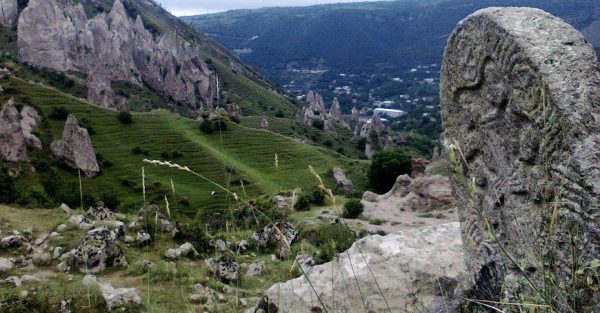
Stepanakert – capital of Artsakh
Stepanakert is the capital city of Artsakh. It bears the name of great revolutioner Stepan Shaumyan. Stepanakert is constructed by the project of Alexander Tamanyan. The clean, cozy city has many nice buildings and parks. Here one can see the famous sculptural work “We and our mountains”, known in the nation as “Grandma and Grandpa”.
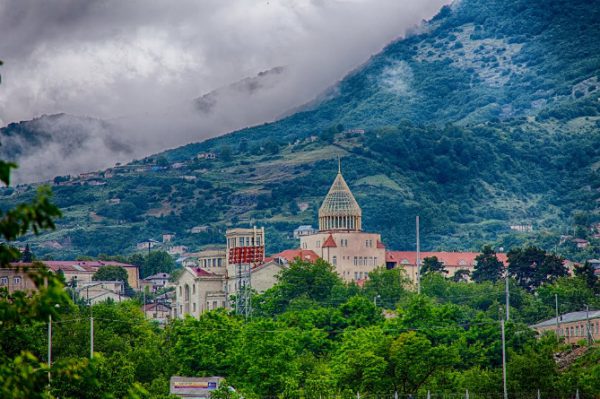
Shoushi
Shoushi, the former capital city of Artsakh, is ten km far from Stepanakert. Shoushi is considered one of the oldest cultural and religious centers of Caucasus. The city is famous for its impregnable fortress and different historical sites. There is also a mosque of 18th century and St. Ghazanchetsots church restored in 1991-1994.
Destinations
Find more information about the countries on the Great Silk Road

 Русский
Русский






